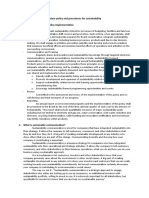0 ratings0% found this document useful (0 votes)
42 viewsElectric Circuits and Devices Lab
Electric Circuits and Devices Lab
Uploaded by
Najmul Puda PappadamThis document provides information about the Electric Circuits and Devices I Lab course at American University of Sharjah for the Fall 2017 semester. The objectives of the lab are to help students use equipment like circuit boards, multimeters, and oscilloscopes to build and test circuits, as well as use PSpice software to simulate circuits. The lab meets weekly over 15 weeks to cover topics like Ohm's law, transient circuits, operational amplifiers, and more. Students are evaluated based on lab reports and a final exam.
Copyright:
© All Rights Reserved
Available Formats
Download as PPT, PDF, TXT or read online from Scribd
Electric Circuits and Devices Lab
Electric Circuits and Devices Lab
Uploaded by
Najmul Puda Pappadam0 ratings0% found this document useful (0 votes)
42 views12 pagesThis document provides information about the Electric Circuits and Devices I Lab course at American University of Sharjah for the Fall 2017 semester. The objectives of the lab are to help students use equipment like circuit boards, multimeters, and oscilloscopes to build and test circuits, as well as use PSpice software to simulate circuits. The lab meets weekly over 15 weeks to cover topics like Ohm's law, transient circuits, operational amplifiers, and more. Students are evaluated based on lab reports and a final exam.
Original Description:
jk
Copyright
© © All Rights Reserved
Available Formats
PPT, PDF, TXT or read online from Scribd
Share this document
Did you find this document useful?
Is this content inappropriate?
This document provides information about the Electric Circuits and Devices I Lab course at American University of Sharjah for the Fall 2017 semester. The objectives of the lab are to help students use equipment like circuit boards, multimeters, and oscilloscopes to build and test circuits, as well as use PSpice software to simulate circuits. The lab meets weekly over 15 weeks to cover topics like Ohm's law, transient circuits, operational amplifiers, and more. Students are evaluated based on lab reports and a final exam.
Copyright:
© All Rights Reserved
Available Formats
Download as PPT, PDF, TXT or read online from Scribd
Download as ppt, pdf, or txt
0 ratings0% found this document useful (0 votes)
42 views12 pagesElectric Circuits and Devices Lab
Electric Circuits and Devices Lab
Uploaded by
Najmul Puda PappadamThis document provides information about the Electric Circuits and Devices I Lab course at American University of Sharjah for the Fall 2017 semester. The objectives of the lab are to help students use equipment like circuit boards, multimeters, and oscilloscopes to build and test circuits, as well as use PSpice software to simulate circuits. The lab meets weekly over 15 weeks to cover topics like Ohm's law, transient circuits, operational amplifiers, and more. Students are evaluated based on lab reports and a final exam.
Copyright:
© All Rights Reserved
Available Formats
Download as PPT, PDF, TXT or read online from Scribd
Download as ppt, pdf, or txt
You are on page 1of 12
American University of Sharjah
College of Engineering
Department of Electrical Engineering
Electric Circuits and Devices I Lab
ELE225R
Fall 2017
Instructor: Ibrahim AbuSeif
Office: EB2-030
Email: iabuseif@aus.edu
Objectives:
This laboratory is designed to accompany the ELE225 course. It aims to help
the student achieve the following objectives:
Use circuit construction boards, multimeters, oscilloscopes, power supplies
and function generators to build and test electric circuits.
Use PSpice to simulate and analyze DC, transient & AC circuits.
Document experimental results in written format.
Lab Schedule
Week Experiment Location
1 Introduction to the Laboratory Circuit Lab
3 Familiarization with digital multimeter and verification Circuit Lab
of Ohms and Kirchhoffs Laws.
4 Basic circuit analysis using PSpice. Computer Lab
5 Familiarization with function generator and oscilloscope. Circuit Lab
6 Thvenin and Norton Equivalents. Circuit Lab + Computer Lab
7 Transient circuit analysis (RC and RL circuits). Circuit Lab
8 Transient circuit analysis using Pspice. Computer Lab
9 Practice Session Circuit Lab
10 Lab Exam Circuit Lab
11 AC circuit analysis. Circuit Lab
12 AC circuit analysis using Pspice. Computer Lab
13 Pspice Exam.
14 Operational Amplifier (OP AMP) basic circuits. Circuit Lab
15 Operational Amplifier (OP AMP) Applications-1 Circuit Lab
16 Operational Amplifier (OP AMP) Applications-2 Circuit Lab
Evaluation
The lab is assigned 15% of course grade. The lab grade is distributed
as follows:
Lab Reports 7.5 %
Lab Exam 7.5 %
Report Submission
Due one week after the completion of experiment.
Individual or group submission depending on experiment.
Late reports will be penalized by considerable grade deduction.
Copied or duplicated work will be assigned a grade of zero and will
also be reported to the course instructor.
Report Writing and Formatting
The laboratory report should be typewritten (word processor) using only one side of each
page. Hand-written reports are not acceptable. Reports should be stapled in the upper left-
hand corner. Each report should follow the outline provided below:
Cover page
Experiment Title
Date
Name and student number
Lab session and group
Name of laboratory partners
Signature
Abstract (not to exceed than half a page)
Outcomes of experiment
Description of procedure
Procedure (presented in the order performed, probably as a numbered list with all
necessary explanatory text)
Circuits figures
Data collected (graphs and plots are often useful)
Answers to questions posed in procedure section of Laboratory Handout
Discussion and Conclusions
General Rules
Print and read the lab handout before the lab session.
Come to the lab on time and dont leave before you
complete the experiment.
keep the work place tidy and clean and return all
instruments, components, wires to their original place.
Mobile phones are to remain switched off during the lab
session.
Circuit Board
The circuit board used in the lab consists of several plastic
blocks of various sizes, all about 0.4 inch (10 mm) thick. Each
plastic block has many holes, into which you insert wires and
plug in resistors and other circuit components.
Inside the plastic block, metal clips snugly hold your wires,
etc., and ensure electric connections between circuit
components.
Some of the holes on PB are connected to each other behind
the plastic: they form nodes, to which you can connect several
things such as a resistor and a wire that goes to the power
supply.
The picture below includes solid lines drawn across each group of
connected holes.
The long rows of connected holes are typically used as bus lines such
as +5 V or the ground; in many experiments, they are connected to
the power supply.
Note that the bus lines at the top and the bottom of the board are
separated in the middle.
The colored stripes along the bus lines serve for color-coding: for
example, if you choose blue for ground, you will easily see all ground
bus lines are on your board
Short rows of 5 holes each are used to build nodes in your circuit. For example,
you can plug a resistor and a wire that goes to the power supply, as shown
below.
Circuit Board Layout
Power Rails
DIP Support
You might also like
- HSBCDocument2 pagesHSBCВлад АнгелNo ratings yet
- Research Proposal 1Document14 pagesResearch Proposal 1maxman200050% (2)
- Electrical and Information Engineering University of Sydney: ELEC3405/5738 Communications Electronics and PhotonicsDocument29 pagesElectrical and Information Engineering University of Sydney: ELEC3405/5738 Communications Electronics and PhotonicssakilakumaresanNo ratings yet
- Experiment 1B - Tubular ReactorDocument14 pagesExperiment 1B - Tubular ReactorNajmul Puda Pappadam100% (1)
- CME 301 - Mass Transfer Differential Equations of Mass Transfer Example ProblemsDocument9 pagesCME 301 - Mass Transfer Differential Equations of Mass Transfer Example ProblemsNajmul Puda PappadamNo ratings yet
- Curriculum EvaluationDocument7 pagesCurriculum EvaluationChristian Manipon90% (10)
- ECE 250 - First Day HandoutDocument9 pagesECE 250 - First Day HandoutswatagodaNo ratings yet
- EEE/EEL 3300L Electronics I Lab Fall 2010: Lab Manual: Course OutlineDocument5 pagesEEE/EEL 3300L Electronics I Lab Fall 2010: Lab Manual: Course OutlinehhcarryNo ratings yet
- 1 Intro & Review of DC CircuitsDocument26 pages1 Intro & Review of DC Circuitsai-bolitNo ratings yet
- ECE 392 ABET Course SyllabusDocument4 pagesECE 392 ABET Course Syllabusdnow4pNo ratings yet
- EE3101 Lab Manual 2013 UMNDocument17 pagesEE3101 Lab Manual 2013 UMNNate LinxNo ratings yet
- IC Applications Lab Manual Satish BabuDocument74 pagesIC Applications Lab Manual Satish BabuRAVIHIMAJANo ratings yet
- EEE111 Lab ManualDocument43 pagesEEE111 Lab ManualManas50% (2)
- EE2002 Lab Manual Fall 2013Document15 pagesEE2002 Lab Manual Fall 2013Alex KeddyNo ratings yet
- Electronics Devices and Circuits LabDocument3 pagesElectronics Devices and Circuits LabsamactrangNo ratings yet
- CN Lab ExperimentsDocument84 pagesCN Lab Experimentssrisridharan0303No ratings yet
- Electronics II: Lab ManualDocument52 pagesElectronics II: Lab ManualGaurav Sharma100% (1)
- Lic Syllabus 4th SemDocument4 pagesLic Syllabus 4th SemYo Yo AnandNo ratings yet
- Iec Exp 10 Student ManualDocument3 pagesIec Exp 10 Student ManualprinceiutNo ratings yet
- PE Lab ManualDocument95 pagesPE Lab ManualSureshNo ratings yet
- Manual 3101Document14 pagesManual 3101craztedNo ratings yet
- ECE 3074 AC Circuits LaboratoryDocument43 pagesECE 3074 AC Circuits LaboratoryZiad Mohmed FawzyNo ratings yet
- EDC Lab ManualDocument88 pagesEDC Lab Manualvanithapremkumar100% (1)
- Electronic Systems Laboratory: AB BjectiveDocument5 pagesElectronic Systems Laboratory: AB BjectiveReddy BabuNo ratings yet
- Eecs166 267 Syllabus15Document3 pagesEecs166 267 Syllabus15Bhanu Pratap ReddyNo ratings yet
- LCA Lab Report 2Document6 pagesLCA Lab Report 2mukarrumofficalNo ratings yet
- 442 Revised Lab Manual w07Document51 pages442 Revised Lab Manual w07srinu247No ratings yet
- Industrial and Power Electronics Laboratory UCI EECS267Document4 pagesIndustrial and Power Electronics Laboratory UCI EECS267Tarun PrakashNo ratings yet
- Physics 6B - Basic Electronics (Systems Approach) OverviewDocument3 pagesPhysics 6B - Basic Electronics (Systems Approach) OverviewIliasNo ratings yet
- Lab Manual EE 2002Document13 pagesLab Manual EE 2002asop06No ratings yet
- Final Circuit ManualDocument59 pagesFinal Circuit ManualMuhammad Ali JoharNo ratings yet
- Laboratory ExercisesDocument28 pagesLaboratory ExerciseskibweantNo ratings yet
- Manual FOR Electrical Engineering Laboratory IiDocument41 pagesManual FOR Electrical Engineering Laboratory IiWilliams A.Subanth Assistant ProfessorNo ratings yet
- LaboratorymanualfordcelectricalcircuitsDocument71 pagesLaboratorymanualfordcelectricalcircuitsJisha VijayanNo ratings yet
- EXP4 Instrumintational AmplifierDocument4 pagesEXP4 Instrumintational AmplifierzaidNo ratings yet
- Ade Lab ManualDocument73 pagesAde Lab ManualAshutosh PatilNo ratings yet
- Department of Information Science and Engineering Analog and Digital Electronics Lab Subject Code: 17Csl37 Lab ManualDocument73 pagesDepartment of Information Science and Engineering Analog and Digital Electronics Lab Subject Code: 17Csl37 Lab ManualrmaffanNo ratings yet
- Aic Lab ManualDocument50 pagesAic Lab ManualVishwanath PetliNo ratings yet
- EENG301LDocument3 pagesEENG301LOmar SroujiNo ratings yet
- Lab Manual 04Document60 pagesLab Manual 04Abhishek PolapallyNo ratings yet
- Electric Circuits Lab Manual (EE247)Document33 pagesElectric Circuits Lab Manual (EE247)moolight.r155No ratings yet
- Lab - 0Document5 pagesLab - 0Samarth SamaNo ratings yet
- EEE 141 Lab Course OutlineDocument4 pagesEEE 141 Lab Course Outlinemahirfaisal58No ratings yet
- Lab 5 - Wireless Power Transfer PDFDocument2 pagesLab 5 - Wireless Power Transfer PDFRuben CollinsNo ratings yet
- Power Electronics Lab ManualDocument76 pagesPower Electronics Lab ManualRaj Tilak100% (1)
- Laboratory Manualfor DCElectrical CircuitsDocument80 pagesLaboratory Manualfor DCElectrical CircuitsEliasMamushetNo ratings yet
- Lecture-1 Course Orientation - AnalogDocument12 pagesLecture-1 Course Orientation - AnalogRekha SinghNo ratings yet
- Electric Circuit Analysis Lab: Electrical Engineering Department The University of Texas at ArlingtonDocument5 pagesElectric Circuit Analysis Lab: Electrical Engineering Department The University of Texas at ArlingtonmsraiNo ratings yet
- Power ElectronicsDocument86 pagesPower ElectronicsMuhammad Ali Johar100% (1)
- Ade - LMDocument75 pagesAde - LMAnimesh KumarNo ratings yet
- EE3446 Lab Manual V1.1Document104 pagesEE3446 Lab Manual V1.1Anthony MorenoNo ratings yet
- Faculty MemberDocument7 pagesFaculty MemberMuhammad FahadNo ratings yet
- RF Fabrication Lab Manual StudentsDocument32 pagesRF Fabrication Lab Manual StudentsTajinder Singh100% (4)
- PH705 Laboratory ManualDocument75 pagesPH705 Laboratory ManualSrikar MadhunapantulaNo ratings yet
- Circuits 1 Lab ManualDocument91 pagesCircuits 1 Lab ManualroylandNo ratings yet
- Circuit AnalysisDocument46 pagesCircuit AnalysisSaleem SonuNo ratings yet
- Experience in Using Electronics WorkbenchDocument1 pageExperience in Using Electronics WorkbenchfpttmmNo ratings yet
- Iec Lab - Exp 06 - Fall 23-24Document5 pagesIec Lab - Exp 06 - Fall 23-24rakibulislamakash400% (1)
- Iec Lab Exp 06Document5 pagesIec Lab Exp 06esumshunNo ratings yet
- Laboratory Manual For DCElectrical CircuitsDocument90 pagesLaboratory Manual For DCElectrical CircuitsChro AbdalwahidNo ratings yet
- Fall2022 Project Lab 11 12Document5 pagesFall2022 Project Lab 11 12Dimitrios MastrogiannisNo ratings yet
- Edge Detection (RC and NAND)Document6 pagesEdge Detection (RC and NAND)librian_30005821No ratings yet
- Circuits 1 Lab ManualDocument90 pagesCircuits 1 Lab ManualAko si GianNo ratings yet
- Arduino Measurements in Science: Advanced Techniques and Data ProjectsFrom EverandArduino Measurements in Science: Advanced Techniques and Data ProjectsNo ratings yet
- Proper Engineering and Management Decisions: Functions of Engineers and ManagersDocument5 pagesProper Engineering and Management Decisions: Functions of Engineers and ManagersNajmul Puda PappadamNo ratings yet
- Chap 3 Part 2 SlidesDocument10 pagesChap 3 Part 2 SlidesNajmul Puda PappadamNo ratings yet
- Experiment 3 - Fixed and Fluidized BedDocument12 pagesExperiment 3 - Fixed and Fluidized BedNajmul Puda Pappadam100% (2)
- Linear Equations in Linear Algebra: Row Reduction and Echelon FormsDocument31 pagesLinear Equations in Linear Algebra: Row Reduction and Echelon FormsNajmul Puda PappadamNo ratings yet
- CME 200 Introduction To Chemical Engineering: Dr. Hadil Abu KhalifehDocument17 pagesCME 200 Introduction To Chemical Engineering: Dr. Hadil Abu KhalifehNajmul Puda PappadamNo ratings yet
- Introduction To Chemical Engineering CME 200 Dr. Hadil Abu Khalifeh Assignment 1Document7 pagesIntroduction To Chemical Engineering CME 200 Dr. Hadil Abu Khalifeh Assignment 1Najmul Puda PappadamNo ratings yet
- Practice 2Document30 pagesPractice 2Najmul Puda PappadamNo ratings yet
- Continuous Distillation Practice 1Document35 pagesContinuous Distillation Practice 1Najmul Puda PappadamNo ratings yet
- Batch Distillation PracticeDocument17 pagesBatch Distillation PracticeNajmul Puda PappadamNo ratings yet
- Chapter 1 - IntroductionDocument55 pagesChapter 1 - IntroductionNajmul Puda PappadamNo ratings yet
- CME 301 - Mass Transfer 1D Mass Transfer With 1 Order Homogeneous Chemical ReactionDocument11 pagesCME 301 - Mass Transfer 1D Mass Transfer With 1 Order Homogeneous Chemical ReactionNajmul Puda PappadamNo ratings yet
- CME 301 - Mass Transfer Lecture 2 - 2 2b. Differential Equations For Steady-State Molecular DiffusionDocument18 pagesCME 301 - Mass Transfer Lecture 2 - 2 2b. Differential Equations For Steady-State Molecular DiffusionNajmul Puda PappadamNo ratings yet
- CME 301 - Mass Transfer Convective Mass Transfer: Dr. Chandra Mouli MRDocument31 pagesCME 301 - Mass Transfer Convective Mass Transfer: Dr. Chandra Mouli MRNajmul Puda PappadamNo ratings yet
- CME 301 - Mass Transfer Differential MT Equations For Unsteady-State Molecular Diffusion (USS-MD)Document24 pagesCME 301 - Mass Transfer Differential MT Equations For Unsteady-State Molecular Diffusion (USS-MD)Najmul Puda PappadamNo ratings yet
- Israeli Textbooks and Children's Literature Promote Racism and Hatred Toward Palestinians and ArabsDocument5 pagesIsraeli Textbooks and Children's Literature Promote Racism and Hatred Toward Palestinians and ArabsNajmul Puda PappadamNo ratings yet
- Chapter 12 - Transient Response of Control Systems2019 UpdateDocument15 pagesChapter 12 - Transient Response of Control Systems2019 UpdateNajmul Puda PappadamNo ratings yet
- Don't Believe Everything You Think! Chapter 1Document17 pagesDon't Believe Everything You Think! Chapter 1Najmul Puda PappadamNo ratings yet
- Review Problems Chapt 25Document5 pagesReview Problems Chapt 25Najmul Puda PappadamNo ratings yet
- Exercises Matura - AllunitsDocument30 pagesExercises Matura - AllunitsRenata FiderkiewiczNo ratings yet
- An Analysis of The Economic Impact of Medical Tourism in ZimbabweDocument9 pagesAn Analysis of The Economic Impact of Medical Tourism in ZimbabweInternational Journal of Application or Innovation in Engineering & ManagementNo ratings yet
- Early Warning SystemsDocument7 pagesEarly Warning SystemsJamalNo ratings yet
- Casestudy 3Document2 pagesCasestudy 3api-344422437No ratings yet
- WLDoc 17 1 20 11 - 17 AMDocument13 pagesWLDoc 17 1 20 11 - 17 AMAnonymous yr4a85No ratings yet
- SIEM Introduction Seminar - Iman MansooriDocument25 pagesSIEM Introduction Seminar - Iman MansooridadavahidNo ratings yet
- Tac Erie Vt/Vs Poptop Series Two Position Spring Return ValvesDocument12 pagesTac Erie Vt/Vs Poptop Series Two Position Spring Return ValvesElmer Ramón Murillo MejiaNo ratings yet
- The Impact of Information Technology OnDocument65 pagesThe Impact of Information Technology OnEndalk ZewdieNo ratings yet
- JQuery TutorialDocument5 pagesJQuery TutorialPallab DattaNo ratings yet
- JokokDocument26 pagesJokokJohn Pattrick LofamiaNo ratings yet
- Cooling System Surge Analysis With AFT ImpulseDocument2 pagesCooling System Surge Analysis With AFT ImpulsektejankarNo ratings yet
- Assessment Task 2 BSBMGT502Document3 pagesAssessment Task 2 BSBMGT502Memay MethaweeNo ratings yet
- Forklift Truck Fuses: Special PurposeDocument4 pagesForklift Truck Fuses: Special PurposeRizqy Fadry LazimNo ratings yet
- Resume by Online Educatio 360Document1 pageResume by Online Educatio 360SlainNo ratings yet
- Pertemuan 2 Perpindahan Panas KonduksiDocument68 pagesPertemuan 2 Perpindahan Panas Konduksifadhillah ivanNo ratings yet
- Case Digest - G.R. No. 142000 - Tagaytay HighlandsDocument3 pagesCase Digest - G.R. No. 142000 - Tagaytay HighlandsCeleste YuNo ratings yet
- 42 Saadsalaryslip 01 11 22Document1 page42 Saadsalaryslip 01 11 22saadbshaheen97No ratings yet
- Analog DevicesDocument10 pagesAnalog Devicesxavier25No ratings yet
- Cost Sheet ProblemsDocument5 pagesCost Sheet ProblemsshamilaNo ratings yet
- Monthly Loan Balance (Excel Lab 1) CH 2Document2 pagesMonthly Loan Balance (Excel Lab 1) CH 2Edgard MoralesNo ratings yet
- MRFDocument6 pagesMRFMiriam Cocos100% (1)
- DSE3110 Installation InstructionsDocument2 pagesDSE3110 Installation InstructionsakmalNo ratings yet
- D6T GCT1-UP Vol2 Edicion June 2013 PDFDocument703 pagesD6T GCT1-UP Vol2 Edicion June 2013 PDFBarzola Soto OmarNo ratings yet
- Qra PDFDocument92 pagesQra PDFHedi Ben MohamedNo ratings yet
- ConnercasememoDocument12 pagesConnercasememoapi-339018690No ratings yet
- CROSSTABSDocument5 pagesCROSSTABSTeuku Hanafi HanafiNo ratings yet
- 1law of Agency.Document18 pages1law of Agency.Murugan RSNo ratings yet













































































































